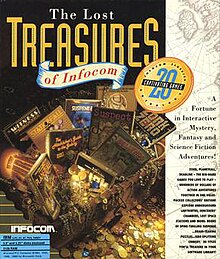Infocom was an American software company based in Cambridge, Massachusetts, that produced numerous works of interactive fiction. They also produced a business application, a relational database called Cornerstone.
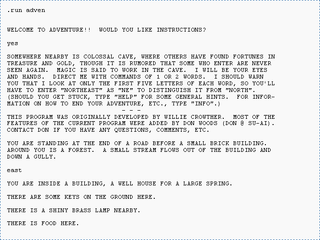
Interactive fiction, often abbreviated IF, is software simulating environments in which players use text commands to control characters and influence the environment. Works in this form can be understood as literary narratives, either in the form of interactive narratives or interactive narrations. These works can also be understood as a form of video game, either in the form of an adventure game or role-playing game. In common usage, the term refers to text adventures, a type of adventure game where the entire interface can be "text-only", however, graphical text adventures still fall under the text adventure category if the main way to interact with the game is by typing text. Some users of the term distinguish between interactive fiction, known as "Puzzle-free", that focuses on narrative, and "text adventures" that focus on puzzles.

Zork is a text-based adventure game, first released in 1977 by developers Tim Anderson, Marc Blank, Bruce Daniels, and Dave Lebling for the PDP-10 mainframe computer. It was expanded by the original developers and others as Infocom and split into three titles—Zork I: The Great Underground Empire, Zork II: The Wizard of Frobozz, and Zork III: The Dungeon Master—which were released commercially for a variety of personal computers beginning in 1980. In the game, the player explores the abandoned Great Underground Empire in search of treasures. The game is composed of hundreds of areas, and the player moves between these areas and interacts with objects in them by typing commands which are interpreted by the game's natural language input system. The program acts as a narrator, describing the player's location and the results of the player's attempted actions. It has been described as the most famous piece of interactive fiction.

Steven Eric Meretzky is an American video game developer. He is best known for creating Infocom games in the early 1980s, including collaborating with author Douglas Adams on the interactive fiction version of The Hitchhiker's Guide to the Galaxy, one of the first games to be certified "platinum" by the Software Publishers Association. Later, he created the Spellcasting trilogy, the flagship adventure series of Legend Entertainment. He has been involved in almost every aspect of game development, from design to production to quality assurance and box design.

Return to Zork is a 1993 graphic adventure game in the Zork series. It was developed by Activision and was the final Zork game to be published under the Infocom label.
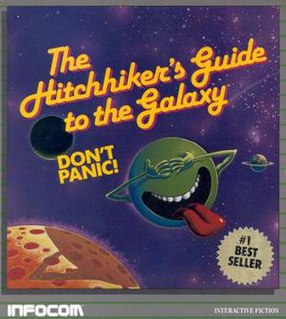
The Hitchhiker's Guide to the Galaxy is an interactive fiction video game based on the comedic science fiction series of the same name. It was designed by series creator Douglas Adams and Infocom's Steve Meretzky, and it was first released in 1984 for the Apple II, Macintosh, Commodore 64, CP/M, MS-DOS, Amiga, Atari 8-bit family, and Atari ST. It is Infocom's fourteenth game.

Peter David Lebling is an interactive fiction game designer (implementor) and programmer who has worked at various companies, including Infocom and Avid.

Leather Goddesses of Phobos is an interactive fiction video game written by Steve Meretzky and published by Infocom in 1986. It was released for the Amiga, Amstrad CPC, Amstrad PCW, Apple II, Macintosh, Atari 8-bit family, Atari ST, Commodore 64, TI-99/4A and MS-DOS. The game was Infocom's first "sex farce", including selectable gender and "naughtiness"—the latter ranging from "tame" to "lewd". It was one of five top-selling Infocom titles to be re-released in Solid Gold versions. It was Infocom's twenty-first game.

Wishbringer: The Magick Stone of Dreams is an interactive fiction video game written by Brian Moriarty and published by Infocom in 1985. It was intended to be an easier game to solve than the typical Infocom release and provide a good introduction to interactive fiction for inexperienced players, and was very well received.
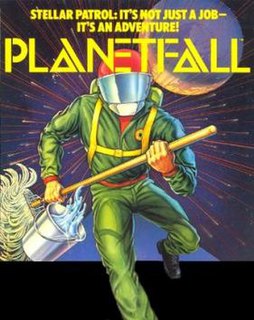
Planetfall is a science fiction themed interactive fiction video game written by Steve Meretzky, and the eighth title published by Infocom in 1983. The original release included versions for Apple II, Atari 8-bit family, TRS-80, and IBM PC compatibles. The Atari ST and Commodore 64 versions were released in 1985. A version for CP/M was also released. Although Planetfall was Meretzky's first title, it proved one of his most popular works and a best-seller for Infocom; it was one of five top-selling titles to be re-released in Solid Gold versions including in-game hints. Planetfall uses the Z-machine originally developed for the Zork franchise and was added as a bonus to the "Zork Anthology".

Enchanter is a 1983 interactive fiction computer game written by Marc Blank and Dave Lebling and published by Infocom. The first fantasy game published by Infocom after the Zork trilogy, it was originally intended to be Zork IV. The game has a parser that understands over 700 words, making it the most advanced interactive fiction game of its time. It was Infocom's ninth game.

Beyond Zork is an interactive fiction computer game written by Brian Moriarty and released by Infocom in 1987. It was one of the last games in the Zork series developed by Infocom. It signified a notable departure from the standard format of Infocom's earlier games which relied purely on text and puzzle-solving: among other features, Beyond Zork incorporated a crude on-screen map, the use of character statistics and levels, and RPG combat elements.
InvisiClues were hint booklets sold by Infocom to help players solve puzzles in their interactive fiction computer games.

Arthur: The Quest for Excalibur is an illustrated interactive fiction video game written by Bob Bates and published by Infocom in 1989. It was released for the Apple II, Amiga, Macintosh, and IBM PC compatibles. Atypically for an Infocom product, it shows illustrations of locations, characters and objects within the game. It is Infocom's thirty-fourth game and is the second of two Infocom games developed by Challenge using Infocom's development tools.
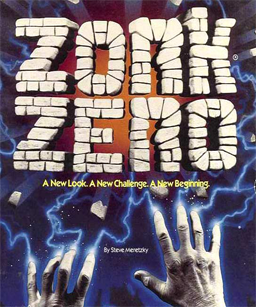
Zork Zero: The Revenge of Megaboz is an interactive fiction computer game, written by Steve Meretzky over nearly 18 months and published by Infocom in 1988. Although it is the ninth and last Zork game released by Infocom before the company's closure, Zork Zero takes place before the previous eight games. Unlike its predecessors, Zork Zero is a vast game, featuring a graphical interface with scene-based colors and borders, an interactive map, menus, an in-game hints system, an interactive Encyclopedia Frobozzica, and playable graphical mini-games. The graphics were created by computer artist James Shook. It is Infocom's thirty-second game.

Moonmist is an interactive fiction computer game written by Stu Galley and Jim Lawrence and published by Infocom in 1986. The game was released simultaneously for the Amiga, Amstrad CPC, Apple II, Atari 8-bit family, Atari ST, Commodore 64, MS-DOS, TRS-80, TI-99/4A, and Macintosh. It is Infocom's twenty-second game. Moonmist was re-released in Infocom's 1995 compilation The Mystery Collection, as well as the 1996 compilation Classic Text Adventure Masterpieces.

James Clavell's Shōgun is an interactive fiction video game written by Dave Lebling and published by Infocom in 1989. It was released for the Amiga, Apple II, MS-DOS, and Macintosh. The game is based on the 1975 novel Shōgun by James Clavell. It is Infocom's thirty-third game.

Journey: The Quest Begins is an interactive fiction computer game designed by Marc Blank, with illustrations by Donald Langosy, and released by Infocom in 1989. Like the majority of Infocom's works, it was released simultaneously for several popular computer platforms, such as the Commodore 64, Apple II, and PC. Journey is unusual among Infocom games in that it could be played entirely via mouse or joystick, with no typing required. It was the thirty-fifth and last game released by Infocom before parent company Activision closed the Cambridge office, effectively reducing Infocom to a "label" to be applied to later games.
Classic Text Adventure Masterpieces of Infocom is a collection of 33 computer games from interactive fiction pioneer Infocom, and the top 6 winners of the 1995 Interactive Fiction Competition, released in 1996. All 39 games are combined on a single cross-platform CD-ROM, which also includes PDFs of all the Infocom games' instructions, maps, and hint booklets.
The Interactive Fiction Collections is a video game series developed by Infocom and published by Activision for the PC.
